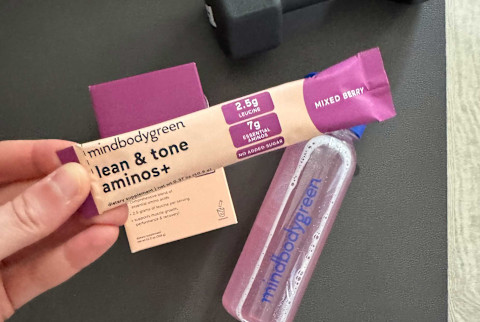How The Right Amino Acids Turn Good Workouts Into Great Results

There’s nothing better than walking out of a workout and feeling like you crushed it. Maybe you grabbed heavier weights for squats this time, had extra gas in the tank during an EMOM circuit, or loaded up the resistance on your bike during spin class. Ok, these are all accomplishments that make me feel great about a workout.
What’s frustrating is when these little wins don’t translate to lasting progress. While picking up 15-pound dumbbells instead of 10-pound for bicep curls feels like a big step forward, when does that new weight actually become your baseline?
Consistency is part of the equation, but so is giving your muscles the support they need to recover and grow. That’s where amino acids come in.
What are amino acids?
When you think about fueling your muscles, protein probably comes to mind first. And you’re right. There’s just a bit more to the story.
Because while total protein intake is crucial to support your muscles and overall health, your body doesn’t use protein in its whole form. Instead, it breaks it down into smaller compounds called amino acids.
It’s these amino acids that are tasked with various jobs in the body. Some amino acids support hormone production (tryptophan is a precursor to serotonin and melatonin), some support gut health and immunity (like glutamine), and some (like lysine) support collagen production.*
All amino acids play a role in muscle health. There are two categories of amino acids that are directly involved in muscle protein synthesis (MPS), the series of processes that repair and build new muscle: Branched-chain amino acids (BCAAs) and essential amino acids (EEAs).
How they support muscle health*
BCAAs may sound familiar to you. Similar to creatine, they are a classic supplement (including leucine, isoleucine, and valine) fitness enthusiasts have been using for ages to build muscle. And yes, they can actually help with that when consumed in the right dose.*
How, you ask? Well, your body needs about 2.5 grams of leucine1 to fully initiative MPS. Once you hit this threshold, the other EAAs (like histidine, lysine, methionine, phenylalanine, threonine, tryptophan) in your system provide the building blocks for creating new proteins.
The body essentially links these EAAs together in the correct sequence to repair and grow muscle fibers.
While leucine isn’t the only trigger of MPS (strength training and hormones also influence it, leucine is the main dietary trigger2).
If you don’t hit that leucine threshold MPS, and if you have insufficient EAA intake it slows or limits MPS. Meaning: Muscle repair and growth are less efficient, and recovery is prolonged.*
Why aren’t you seeing the results you want from workouts?
If your diet is lacking leucine or other EAA, then you may see your strength plateauing at the gym. And even if you are eating enough protein throughout the day, the balance of amino acids foods provide can vary greatly, and hitting the leucine threshold through food alone can be tricky.
For example, a palm-sized piece of chicken or salmon provides roughly 2 grams of leucine, and a cup of cooked lentils offers less than 1 gram.
So for someone looking to optimize muscle growth and recovery, relying solely on diet can make it difficult to consistently reach the levels your body needs.
How to reach the leucine threshold
Cue mindbodygreen’s lean & tone aminos+. Each serving of this (berry-flavored) powder provides an optimal 2.5-gram dose of leucine plus all other BCAAs and EAAs.
When taken consistently, this full-spectrum amino acid supplement can help promote muscle protein synthesis and recovery after one week, enhance physical performance and lean body mass within eight weeks, and further strength gains around three months.*†
Just mix one stick pack with 8 ounces of water. You can sip it before, during, or after a workout3. Or if you do happen to find yourself eating a lower-protein meal (it happens to all of us!), drink this for some added MPS support.
The takeaway
Consistent workouts are only part of the equation for building strength, recovering efficiently, and reshaping your body.
Giving your muscles the support they need with the right balance of amino acids is what turns hard work into real results.*

